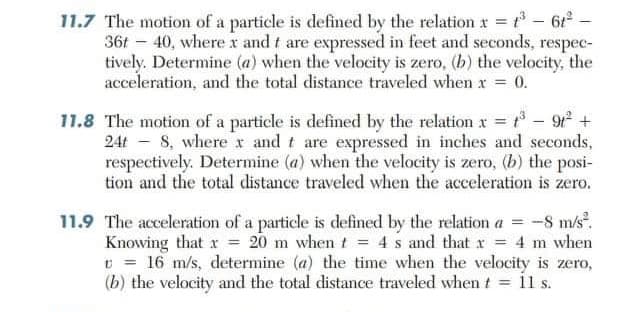The motion of a particle is defined by the relation x =-6t- 36t - 40, where r and t are expressed in feet and seconds, respec- tively. Determine (a) when the velocity is zero, (b) the velocity, the acceleration, and the total distance traveled when x = 0.
The motion of a particle is defined by the relation x =-6t- 36t - 40, where r and t are expressed in feet and seconds, respec- tively. Determine (a) when the velocity is zero, (b) the velocity, the acceleration, and the total distance traveled when x = 0.
Principles of Physics: A Calculus-Based Text
5th Edition
ISBN:9781133104261
Author:Raymond A. Serway, John W. Jewett
Publisher:Raymond A. Serway, John W. Jewett
Chapter4: The Laws Of Motion
Section: Chapter Questions
Problem 54P: A student is asked to measure the acceleration of a glider on a frictionless, inclined plane, using...
Related questions
Concept explainers
Topic Video
Question

Transcribed Image Text:11.7 The motion of a particle is defined by the relation x = - 6-
36t – 40, where x and t are expressed in feet and seconds, respec-
tively. Determine (a) when the velocity is zero, (b) the velocity, the
acceleration, and the total distance traveled when x = 0.
11.8 The motion of a particle is defined by the relation x = - 9 +
24t - 8, where r and t are expressed in inches and seconds,
respectively. Determine (a) when the velocity is zero, (b) the posi-
tion and the total distance traveled when the acceleration is zero.
11.9 The acceleration of a particle is defined by the relation a = -8 m/s.
Knowing that x = 20 m when t = 4 s and that r = 4 m when
v = 16 m/s, determine (a) the time when the velocity is zero,
(b) the velocity and the total distance traveled when t = il s.
Expert Solution
This question has been solved!
Explore an expertly crafted, step-by-step solution for a thorough understanding of key concepts.
This is a popular solution!
Trending now
This is a popular solution!
Step by step
Solved in 3 steps with 3 images

Knowledge Booster
Learn more about
Need a deep-dive on the concept behind this application? Look no further. Learn more about this topic, physics and related others by exploring similar questions and additional content below.Recommended textbooks for you

Principles of Physics: A Calculus-Based Text
Physics
ISBN:
9781133104261
Author:
Raymond A. Serway, John W. Jewett
Publisher:
Cengage Learning

Physics for Scientists and Engineers: Foundations…
Physics
ISBN:
9781133939146
Author:
Katz, Debora M.
Publisher:
Cengage Learning

Classical Dynamics of Particles and Systems
Physics
ISBN:
9780534408961
Author:
Stephen T. Thornton, Jerry B. Marion
Publisher:
Cengage Learning

Principles of Physics: A Calculus-Based Text
Physics
ISBN:
9781133104261
Author:
Raymond A. Serway, John W. Jewett
Publisher:
Cengage Learning

Physics for Scientists and Engineers: Foundations…
Physics
ISBN:
9781133939146
Author:
Katz, Debora M.
Publisher:
Cengage Learning

Classical Dynamics of Particles and Systems
Physics
ISBN:
9780534408961
Author:
Stephen T. Thornton, Jerry B. Marion
Publisher:
Cengage Learning